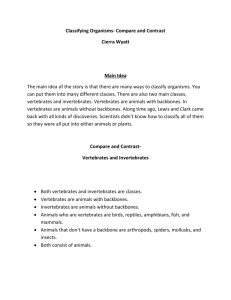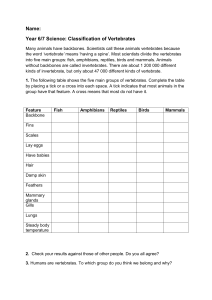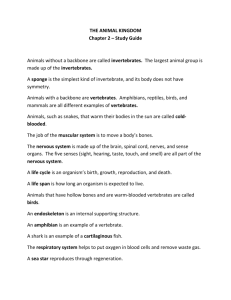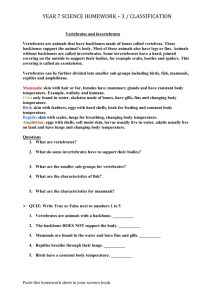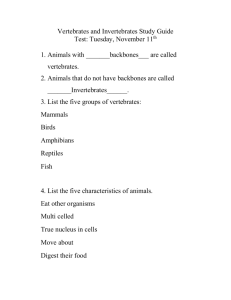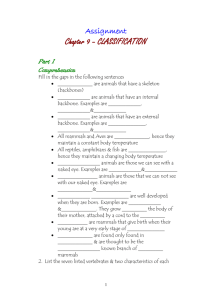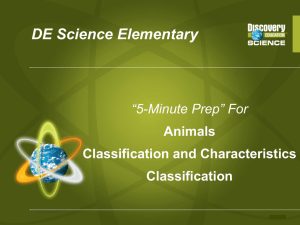Chapter 2: How Animals Live
advertisement
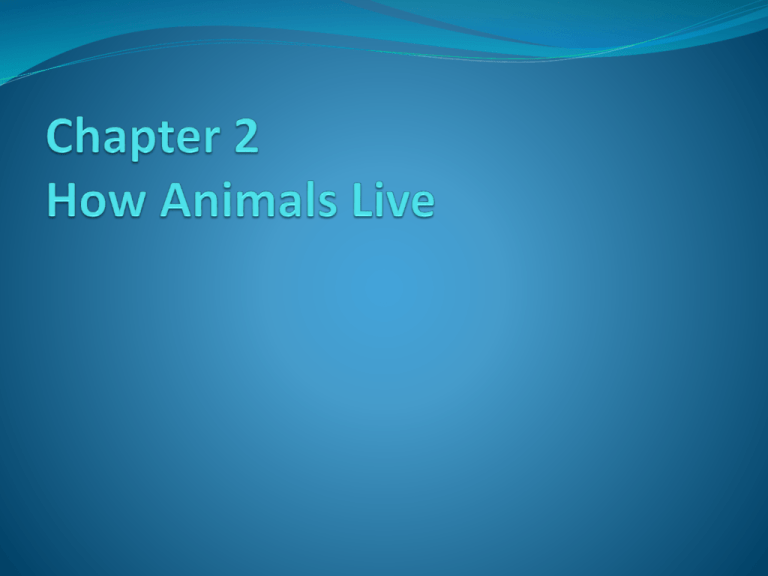
Many Changes Vertebrates Groups Animals Few Changes (mammals) Invertebrates Physical Traits Life Cycles Adaptations Behavior Let’s Explore! How can we make a model of a backbone? 1 pipe cleaner 10 pieces of wagon wheel pasta 9 soft fruit jelly rings Explain Your Results How is your model different from a real backbone? How is your model like a real backbone? Write in your scientist’s journal? Reach around and feel your backbone. Describe what you feel. Now feel the jelly rings and the pasta and tell how they’re different. 1. Bend the end of a pipe cleaner into a knot. String a piece of wagon wheel pasta on the pipe cleaner so the pasta rests on the knot. Next, string a jelly ring. 2. Add another wheel and a ring. Keep going until you have used 10 wheels and 9 rings. 3. Bend the other end of the pipe cleaner. Make a knot to hold everything on. Can you bend your model backbone? Chapter 2 Vocabulary trait- a feature passed down on to a living thing from its parents vertebrate- an animal with a backbone larva- stage in an insect’s life after it hatches from the egg pupa- stage in an insect’s life between larva and adult adaptation-trait that helps a living thing survive in its environment inherited- passed on from parent to offspring migrate- to move to another place to find better climate, food, or a mate hibernate- to spend winter resting; body systems slow down in order to save energy How to Read Science: Sequence Sequence Sequence is the order in which events take place. Clue words such as first, next, then, and finally can help you figure out the sequence of events. They are marked on the museum display card. Sea Jelly A sea jelly grows up in stages. First, an adult makes young called young larvae. Next, each larvae becomes attached to a rock. Then, each larva grows and becomes a polyp. Finally, each polyp grows into a group of young adults. Apply It! Make a graphic organizer as a model to show the life cycle of the sea jelly. Write each of the four events in the life cycle after the four clue words. FIRST The adult make young called larvae. NEXT Each larvae becomes attached to a rock. THEN Each larva grows and becomes a polyp. FINALLY Each polyp grows into a group of young adults. Lesson 1: How are Animals Grouped? Close your eyes and imagine this scene. It’s early morning in the forest and the birds are singing. You look down at your feet and notice ants marching by. You stand very still, listening and watching. Suddenly, you spot what looks like two dogs walking through a grassy field in the distance. As you focus your eyes you realize they are not dogs. You’ve spotted a wolf and her pup! How many different animals did you picture? Animals come in many shapes and sizes. Even though they may be different, do animals need the same basic things to live? What All Animals Need All animals have the same basic needs. Needs of Animals Water Oxygen Food Shelter Journal: Write about how your favorite animal meets its basic needs. Ways of Grouping Animals Animals can be grouped in different ways: where they live How they act How they look Body feature (trait) Vertebrate vs. invertebrate Vertebrates are animals with backbones. There are 5 groups of vertebrates. Invertebrates are animals without backbones. There are 4 major kinds of invertebrates. Groups of Vertebrates Groups of Vertebrates (Animals with a Backbone) Fish These vertebrates spend their entire lives in fresh water, ocean water, or both. Most fish have slippery scales and breathe through gills. Many amphibians spend part of their lives in water and Amphibians part on land. The word amphibian means literally means “double life”. Reptiles Snakes, lizards, turtles, crocodiles, and alligators are Reptiles. They mostly have dry, scaly skin. They breathe air through lungs. Birds Birds have feather and bills that do not have teeth. They breathe air through lungs. Wings and light bones help most birds fly. Feathers help them stay warm. Mammals Mammals have hair at least during part of their lives. The hair keeps them warm. Mammals breathe air through lungs and feed milk to their young. Animals without Backbones Most animals do not have skeletons made of bone inside their bodies. These are animals without backbones, or invertebrates. It’s hard sometimes to notice invertebrates because they usually are so small. But they are everywhere! In fact, there are many more invertebrates than vertebrates. Kinds of Animals Vertebrates Kinds of Invertebrate Animals Worms Sea Jellies Mollusks Insects Invertebrates Other Arthropods Major Kinds of Invertebrates Four Major Types of Animals without Backbones Sea Jellies Sea jellies have soft bodies and long, stinging body parts. The body of a sea jelly is made mostly of water. It uses its stingers to stun its prey before pulling it into its stomach. Worms Worms are animals with long, soft bodies and no legs. You’ve probably seen an earthworm in the soil. They help keep the soil healthy. Mollusks Mollusks are animals with soft bodies. Some mollusks include the octopus, squid, clam, and snail. Many mollusks have a hard shell. Arthropods These animals are members of the largest group of invertebrates. They wear their skeletons on the outside of their bodies. Insects, spiders, and crabs are arthropods. 1. What do all animals need to live and survive? 2. What is the difference between a vertebrate and an invertebrate? Scientist’s Journal List the five vertebrate groups. For each group, draw and label an example and write a word that relates to an animal from this group. The word might be a sound that the animal makes, its color, its food, or its behavior. A Butterfly’s Life Cycle 4 Adult butterflies lay eggs. PUPA Inside a hard covering, the larva’s body changes. 3 The adult butterfly comes out of the chrysalis. 2 1 EGG This is a close-up view of a very small egg. LARVA The butterfly larva is called a caterpillar. Vertebrate Life Cycles Vertebrates have different kinds of life cycles. Some vertebrates, like frogs, go through many changes as they grow and mature. Other vertebrates, like pandas or monkeys, do not change as much. A Mammal’s Life Cycle Unlike amphibians and insects, young mammals do not change very much as they become adults. Many mammals look like their parents when they are born. Most mammals develop inside their mother’s bodies. When they are born, the babies drink milk from their mothers. They also have hair or fur. Even though it’s very small, a new-born panda pup has the same body form as its parents. A Frog’s Life Cycle 2 3 TADPOLE Tadpoles hatch from the frog eggs. Tadpoles live underwater and breathe with gills. 1 EGGS Mother frogs often lay hundreds or thousands of eggs in the water. 4 GROWING TADPOLE As the tadpole grows, it starts to change. Its tail becomes shorter. Legs begin to grow. The back legs grow first. ADULT FROG The adult frog lives on land and in the water. It will need to return to the water to lay its eggs. Lesson 2: How Do Animals Grow and Change? Different animals have their young in different ways. But all animals grow and change during their life cycle. Life Cycle Stages Birth Growth Animals are born or hatch. Animals get bigger. Development Animals change into adults. Reproduction Animals produce young. Death Animals’ lives come to an end. 1. What are the five life cycle stages? Describe each stage. 2. Before a frog can live on land, how must its body change? Scientist’s Journal How is a mammal’s, such as a panda, life cycle different from a butterfly’s life cycle? Explain each animal’s life cycle. Use pictures, words, diagrams, and labels. Lesson 3: How do Adaptations Help Animals? Animals have special body parts, features, and ways of doing things that help them survive in their environments. A trait that helps an animal meet its needs in the place where it lives is called an adaptation. Adaptations are inherited, or passed on, from parents to their young. There are many different kinds of adaptations. Most kinds, such as body color, differ between members of even closely related groups. This porcupine skull shows adaptations of a plant-eating animal. Sharp front teeth cut off parts of plants. Flat teeth in the back of the jaw move from side to side, grinding tough plant material. This hyena skull shows adaptations of a meateating animal. Sharp front teeth tear off meant and back teeth shred it. The webbed feet of a pelican help it swim and survive in the water where it finds its food. Adaptations for Getting Food A long, curved bill helps the flamingo filter food from shallow water. A sharp, strong bill helps the cardinal break open seeds. The bill of a pelican has a pouch that hangs from it. When it swoops into the water for food, the pouch acts like a net to help the bird catch fish. A small, thin bill helps the warbler pick out insects for food. Adaptations for Protection The way an animal looks and the way it acts can help it survive. Some animals protect themselves by blending into their surroundings so they are hard to spot. This is called camouflage. Other animals protect themselves by looking like a dangerous or poisonous animal. The adaptations is called mimicry. The animals mimic or copy another animal. The animal being copied is usually more dangerous. Many animals will climb, run, hop, jump, fly, or swim away from danger. Animals may also use poison to protect themselves. Animals such as skunks and weasels will spray a bad odor at their enemies. Special body parts such as shells, teeth, claws, hooves, bills, or pointed body parts also protect animals from danger. Porcupines have loose, barbed quills to protect them from their enemies. Ways Animals Protect Themselves Camouflage Armor Mimicry Poison A viceroy butterfly looks like a badtasting monarch butterfly. Animals that can be harmed by this crab spider cannot see it. The fur color of the arctic fox changes with the seasons. Spikes and horns protect this horned lizard. A cassowary has a tough helmet to This king snake looks protect its similar to the deadly head. coral snake. Lion fish have poisonous spines. Coral snakes bite with poisonous fangs. Behaviors That Help Animals Behaviors are things that animals do. Animals are born being able to do some things. These behaviors are inherited. Other behaviors must be learned. Instincts An instinct is a behavior an animal is born able to do. For example, one instinct is an animal’s response to hunger. Baby birds will open their mouths when they sense a parent with food is near. Some animals have an instinct to move, or migrate, when the seasons change. Other animals have an instinct to hibernate during the cold winter months. Learning Animals learn some behaviors from their parents and other animals. For example, chimpanzees can learn how to use tools like sticks to catch insects to eat. They are not born knowing how to use a stick. They learn how to do this by watching other chimpanzees. Young chimpanzees also learn which foods are safe to eat from their mothers and other adults. 1. Name two types of adaptations having to do with an animal’s actions. 2. What is the difference between an instinct and a learned behavior? Scientist’s Journal Make a chart naming the four ways animals protect themselves. Include the definition and an example of an animal who uses that adaptation for protection.


